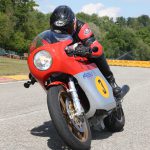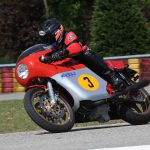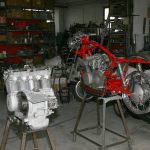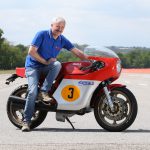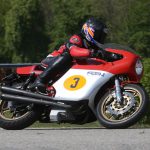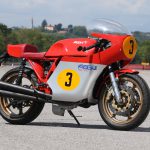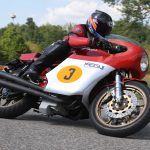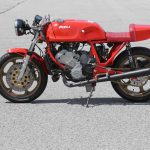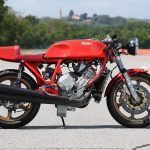Back to the future – the Latin way
Exclusive test of first ever Magni model produced by Italian family business using its own frame to house a three-cylinder MV Agusta engine from the marque which the company’s late founder Arturo Magni played such a vital role in making famous.
One problem with modern day retro bikes is that in trying to combine ancient with modern, they often risk embracing the worst of both worlds, and the best of neither. In trying to recreate all our yesterdays in a modern context, their builders sometimes end up with too much motor for the chassis, or insufficient poke to pull the skin off a rice pudding. Better to just stick the result on display and simply look at it – reflecting as you do how far and how fast the world has moved on since the bike it’s trying to honour first did its thing.
But then every so often one comes along that is so totally right, and so luscious to look at as well as fun to ride, that you forget all the times you’ve been disappointed, and start looking at yesterday through distinctly rose-tinted spectacles. For sure that’s the case with Italy’s Magni MV Agusta Filorosso triple that’s now being handbuilt in limited quantities – sufficient nonetheless to constitute series production – by Giovanni Magni in the Moto Magni factory north of Milan at Samarate. That’s a stone’s throw from MV’s former race HQ at Gallarate where his late dad Arturo – who passed away in December 2015 at the age of 90 – led the historic Italian trophy marque’s GP team, bankrolled by the profits of Count Agusta’s helicopter factory, to a remarkable haul of 75 road racing World Championships in 26 years.
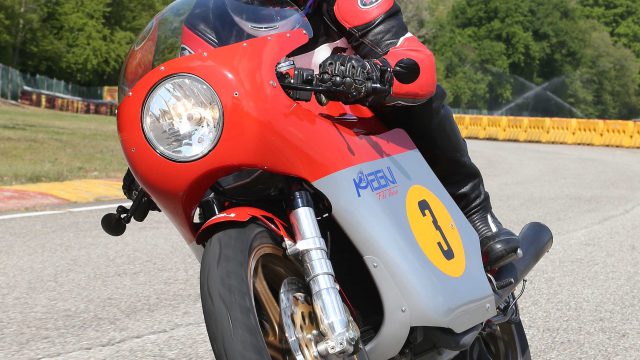
It’s hard to think of any company more entitled than Moto Magni to use a current MV Agusta model to produce an authentic retro-racer, and that’s what the firm’s director, Arturo’s youngest son Giovanni, 57, has indeed now done in going back to the future in creating the Filorosso – Italian for ‘red line’, as in taking it to the limit. This exquisitely designed, superbly executed and classically striking road-legal three-cylinder racer-with-lights looks for all the world like the 500 triple that MV’s 15-time World champion Giacomo Agostini took to seven successive 500GP World titles from 1966-72, before switching to Yamaha. But in fact, it’s a cleverly concocted creation which uses an unmodified modern liquid-cooled Brutale 800 motor, sourced together with the Eldor ECU and wiring harness directly from today’s MV Agusta factory, 40km away on the shores of Lake Varese. This has been wrapped by Giovanni in a TiG-welded open cradle chrome-moly tubular steel frame using the engine as a fully stressed component, which recalls Ago’s World title-winning triple’s twin-loop chassis, complete with box-section twin-shock swingarm and 18-inch wheels. These are in fact six-spoke cast magnesium items as fitted to MV’s later 350/500 four-cylinder GP racers and are the product of the Magni family’s other business, the EPM wheel manufacturer run by Giovanni’s elder brother Carlo.
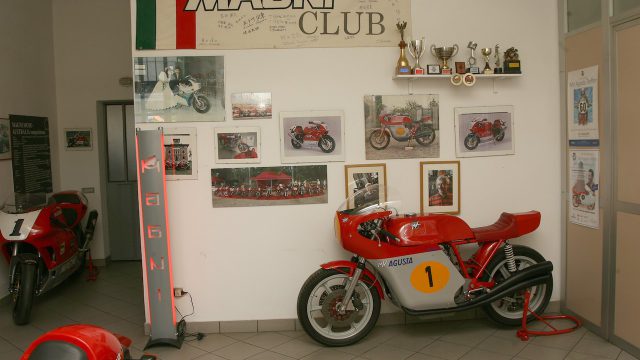
“I always dreamed of making a modern Magni MV, in the same way as my father did 40 years ago when he started our company,” says Giovanni Magni with a shy but passionate smile. “And many of our existing customers were asking us to make an MV Agusta-based bike that was a blend of today’s engineering with traditional aesthetics – a bike that recalls MV’s glorious history but in a modern context, with today’s performance. But I was always reluctant to do so because of the responsibility of living up to the expectations created by such a historic marque. I mean, you can’t dare to even think of building a bad MV, a bike that doesn’t meet the high standards set by that badge on the tank, can you? But then Claudio Castiglioni [MV’s late owner, who revived the brand in 1998 after a 20-year slumber – AC] passed away in the summer of 2011, and he’d always been such a strong supporter of what my father and I were doing, and I wanted to recognise that in some way.” Giovanni’s first Magni MV tribute bike was the four-cylinder Storia, a classically restyled stock-framed Brutale 1090 that was unveiled at the 2013 Milan Show, and continues in production. But although he’s delivered over 30 such bikes, and has more orders coming in all the time, Giovanni got criticised by some for just offering a change of clothes with the Storia, because it doesn’t have a Magni frame. So without telling anyone else, not even their dad, he and Carlo decided to make a three-cylinder bike using the 800 Brutale F3 motor in a purpose-built period-style Magni frame.
However, this happened almost by accident. “The Filorosso started almost as a joke,” says Giovanni. “I was so annoyed about the criticism I’d got for the Storia that I decided to do something I never thought I’d dare to do, and make a modern three-cylinder Magni MV, not a four. I mean, Agostini’s triple was the ultimate MV Agusta that he won so many races and championships with, so you can’t risk making something that’s supposed to be in the spirit of such an iconic bike, but fails to live up to the expectations aroused by that. But I was so cross I decided to design it almost as therapy, and to make a bike that pleased me personally, rather than worry about what other people said. Plus my father had been MV’s Direttore Sportivo all through the triple’s racing career, and I knew it would please him if I did it. So I bought a used Brutale 800 F3 engine from an MV dealer – the first generation one with 125 bhp, though the current version in the bikes we deliver is more powerful, with 140 bhp – and Carlo and I measured everything up. That’s when I realised not only what a beautiful-looking engine it is, but also how compact it is, too. So then it became obvious what I had to do – make a modern version of Agostini’s GP racer with lights and a horn, but with quite a bit more performance than even the six recent Evoluzione copies of the 500GP triple which Claudio Castiglioni had his guys in the factory make while he was still alive. Ago rides one of those today in all the Classic parades he takes part in – but with 60% more cubic capacity than his bike the Filorosso has even more performance, even if it weighs quite a bit more at 167kg dry [vs. 128kg for the GP racer – AC].”
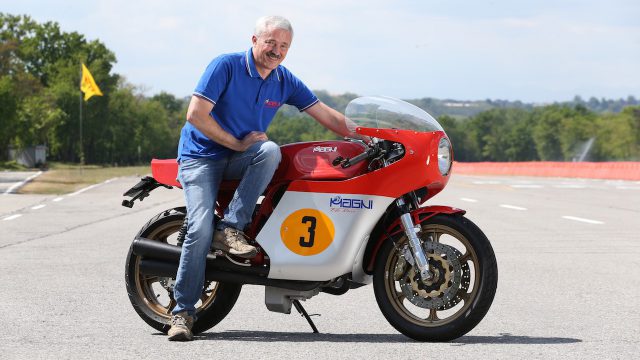
Working flat out for three months, the two brothers finished the prototype Filorosso three days before the opening of the 2014 EICMA Milan Show. “It was complete, but not running – so we just took some photos of it, and posted them on our website with a few words explaining what it was, then went to bed,” recalls Giovanni with a smile. “Next morning, we found the website had crashed, and we had a dozen orders for the bike without anyone knowing the price, for the simple reason we hadn’t decided on it yet ourselves!” One year later the definitive version was displayed at EICMA 2015, having been extensively road tested to iron out any problems, and production kicked off, with the bikes built in batches of five at a tax-free price of Euro 29,500, and a six-month lead time before delivery. Hurry, hurry…. But there won’t be any kits available from Magni for customers to build up a bike at home, as with the company’s other products. “We’re only going to be selling complete bikes,” says Giovanni Magni, “because we have no problem with sourcing brand new engines from MV Agusta, When he came to see the finished bike [MV Agusta owner] Giovanni Castiglioni stood looking at it for some moments. Then he turned to me and said, “Whatever you need from me to manufacture this motorcycle, just ask.” So we have direct support from the MV Agusta factory, which is very reassuring.”
I’ve been privileged to ride many wonderful racers down the years, from Fogarty Ducatis to Valentino’s M1 Yamahas, and a host of exotic classic racers into the bargain. But the one that gets my blood racing and my heart soaring is the MV Agusta triple, because no other motorcycle so completely captures the sound as well as the substance of two-wheeled exotica, of the kind of engineering mystique that wins serial world titles. It’s The One. I’m fortunate to have ridden one of the 16 genuine three-cylinder GP racers (in both 350 and 500 versions) which Count Agusta’s race team built in total down the years – as well as the last of the six Evoluzione bikes produced by Claudio Castiglioni before he died. So I have a pretty good idea of what it’s like to sit on the bike that, as for many other people, is right up there when it comes to settling on my favourite ever racebike – and the Filorosso is uncannily similar, right down to its deceptively diminutive stature.
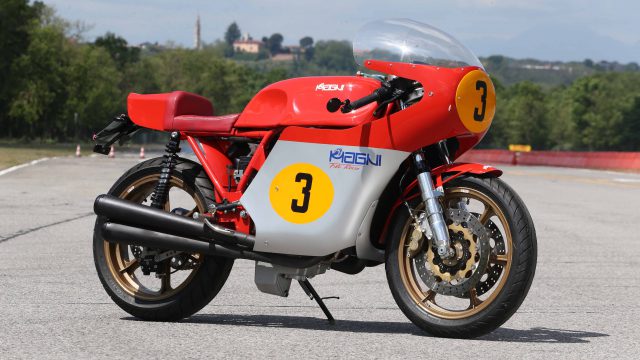
Though it’s so perfectly proportioned that until you sit aboard the Magni MV you’ve no idea it’s so relatively tiny – quite low, but also pretty short, with a compact 1370mm wheelbase (against 1310mm for Ago’s GP racer) removing all sense of bulk – it’s not until you see it without the fairing that you’re aware of how perfectly packaged the Filorosso is. Thanks to the F3 engine being painted silver and thus pretty eye-catching, the low-mounted stock Brutale water radiator is so visually unobtrusive that you don’t really notice it. There’s just enough space for a 5’10”/1.80m rider, though the footrests are very high – Giovanni Magni says he had to raise them, because his youthful Supersport test rider kept decking them! – and you’re pretty much wedged in place, seated quite far back on top of the rear suspension.
This gives room for you to stretch out along the 16-litre hand-beaten aluminium fuel tank to the low mounted, steeply dropped clipons, and in so doing make space to crouch behind the screen, as well as make a stab at tucking your knees inside the fairing in a straight line. You’re discouraged from moving about the bike thanks to the cramped riding position, but that’s OK, because the way to ride a motorcycle like this is definitely not to try to hang off it and stick your knee on the ground. Instead, you must try to keep tucked in aboard it, and use the sharp steering geometry (a 25º rake for the fully adjustable but definitely period-looking Forcella Italia conventional fork, with just 85mm of trail via a 60mm offset on the machined-from-solid tripleclamps), to flick the Filorosso through tighter turns while you stay glued to the seat.
Moreover, I found you must keep up turn speed in faster fourth-gear bends at the Pirelli test track near Malpensa Airport where I rode the bike, by relying on the good grip from the skinny 110/80 ZR18 Metzeler Roadtec Z8 mounted on the 2.50 in. EPM front rim to stay tucked behind the screen in pursuit of extra k’s. Riding the Filorosso is just like racing a Classic 500 single – only with a lot more power, and heaps more music! The bodywork is just wide enough to give good streamlining, with your shoulders adequately protected by the fairly broad screen as you wrap yourself around the tank, and allow your eyes to peer at the rather cluttered stock MV dash – sorry, no period-style white-faced Veglia tacho! – into which the Eldor ECU is integrated. Giovanni Magni has jettisoned the traction control and anti-wheelie control programmes incorporated in this by simply not installing the requisite sensors, and there’s no ABS, either. But he’s thankfully retained the powershifter on the street-pattern six-speed gearbox, and listening to the three gracefully tapering megaphone pipes’ slightly muted (via internal silencing) but still gloriously evocative exhaust note change just an octave or so as you hit a higher gear rounding a wide-open sweeper, is two-wheeled audio paradise. So too when you crack the throttle open is the suction roar coming from the trio of 50mm Mikuni throttle bodies nestling openly beneath the fuel tank, each protected against stones and debris as was the way Back Then by a wire mesh cover over its induction trumpet (aka velocity stack), thanks to the stock Brutale airbox having been jettisoned.
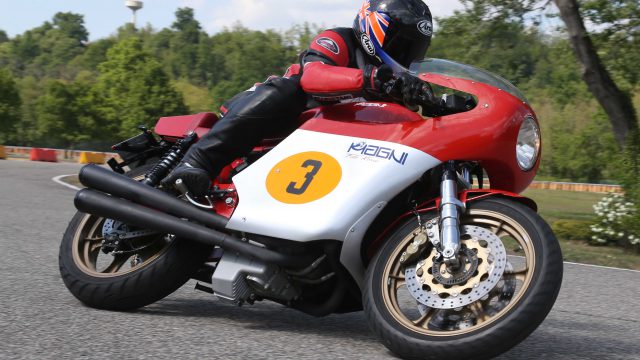
We’d come to the Pista Pirelli for me to ride the bike because, ahem, it isn’t road legal in Italy, in spite of being supplied with full lighting equipment, with the front headlamp neatly inserted in the nose of the GP-style fairing, and covered by a yellow raceplate that can be unbolted. The turn signals and other such hardware come courtesy of the neighbouring Rizoma factory close by Moto Magni’s base, whose R&D boss is coincidentally ex-MV Agusta GP mechanic Fiorenzo Fanali, later with Yamaha, Cagiva and and Kawasaki. The reason the Filorosso isn’t homologated for the street is simply one of cost, plus the time needed to add ABS, sanitise the exhaust system via a catalyst, and figure out a way of wrapping the throttle bodies in some kind of airbox. However, there’s a good reason for that. “We have many orders for the bike in spite of the fact it’s not road legal in Italy,” says Giovanni Magni. “We leave it to our customers in whichever country they live in to get it registered there if they wish to. But I know some of them prefer just to ride it on the track – it’s their choice.” The result is a motorcycle that’s as authentic a modern-day tribute as it’s possible to get to what’s arguably the most iconic Italian racebike ever made – even if the only thing missing is the tennis ball with the top cut off which Ago used to mount on the left clipon, in which he’d carry a damp sponge with which to wipe insects off his goggles during the hour-long GP races – or two-hour TTs – of the day. We have tear-offs today, instead!
Another more important difference is that, while not exactly inexpensive, the Magni Filorosso is worth a fraction of the cost in purely cash terms, let alone in historic value, of a genuine factory MV-3 racer. So that means you can ride it in something approaching anger in a way that would be unthinkable today on a period bike – the MV triples you see racing today in the Goodwood Revival and Classic TT are all replicas. Doing so at the Pista Pirelli revealed a bike that feels small, light, low slung and very well balanced, with light, agile steering and good feedback from the front Metzeler. It holds a line well, and even though the twin rear shocks are period kit that isn’t very sophisticated in damping terms, there aren’t enough bumps on the Pista Pirelli to deliver an examination of their capability, But in spite of being so short the Magni Filorosso was super stable round a fast fifth-gear sweeper, and it not only steers well, but stops brilliantly too. The twin 320mm Brembo front discs gripped by axially-mounted four-pot calipers are heaps more effective than the drum brakes fitted to the early GP triples, or the plasma-sprayed aluminium Hunt discs which replaced them and didn’t really work any better, with a rather dead feel which was compensated for by their significantly reduced unsprung weight. The Filorosso’s vastly more effective Brembo package is more than good enough to haul a bike weighing 167kg dry down hard from high speed – though you must be careful about squeezing too hard on the adjustable lever, else with that short wheelbase you risk street-sweeping the tarmac with the back wheel in the air. You must make a point of using the rear 230mm brake with its twin-piston caliper a fraction before you brake really hard with the front, to preload the suspension on such a short bike, and get the 49.5/50.5% weight bias to work in your favour.
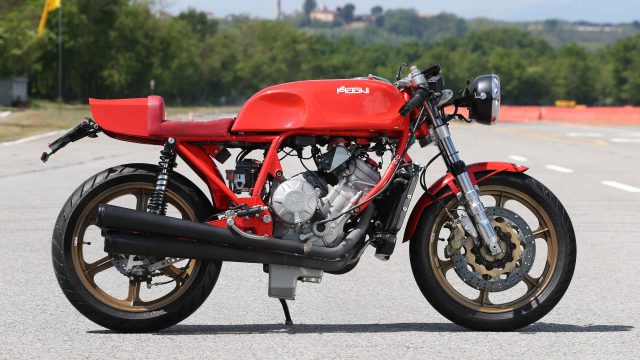
Another big difference on the Filorosso is the Brutale 800 motor’s electric leg. So instead of the bump start that Ago was so adept at on the GP triple, changing into third gear at the dead engine start of a period GP race by the time the British singles and Japanese two-strokes the MV-3 spent much of its career competing against had fired up and been clutched up onto the pipe, to start the Filorosso’s motor you just thumb the starter button, But you’ll invariably find yourself sitting there for a moment relishing the rasping offbeat engine note, before you pull in the light action clutch lever, hit bottom gear, and suddenly the trombone exhausts are playing their melody as the revs ride and you head out onto the track. The three-cylinder Brutale 800 engine pulls strongly from low down, and you can accelerate wide open in sixth gear from just 2,000 revs without a hint of transmission snatch. At 3,000 rpm it starts to take off, and you can feel the extra kick at around 7,000 rpm when you hit maximum torque, then surf the curve all the way to the thirteen grand limiter, accompanied by that deep, sonorous exhaust note that’s good enough to bottle. Magic.
Riding the Magni MV Filorosso was an emotional trip down memory lane, complete with all mod cons – well, except TC and ABS, I suppose. I bet Arturo Magni went to meet his maker suitably content with the ultimate creation of the brand he founded 40 years ago. Retro bikes don’t come any better than this.
* * * * *
Photo credit: Kel Edge
